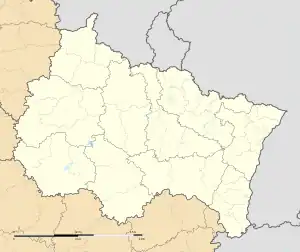Cumières-le-Mort-Homme | |
|---|---|
 The war memorial in Cumières-le-Mort-Homme | |
 Coat of arms | |
Location of Cumières-le-Mort-Homme | |
 Cumières-le-Mort-Homme  Cumières-le-Mort-Homme | |
| Coordinates: 49°14′00″N 5°16′54″E / 49.2333°N 5.2817°E | |
| Country | France |
| Region | Grand Est |
| Department | Meuse |
| Arrondissement | Verdun |
| Canton | Belleville-sur-Meuse |
| Intercommunality | CA Grand Verdun |
| Area 1 | 6.11 km2 (2.36 sq mi) |
| Population | 0 |
| • Density | 0.0/km2 (0.0/sq mi) |
| Time zone | UTC+01:00 (CET) |
| • Summer (DST) | UTC+02:00 (CEST) |
| INSEE/Postal code | 55139 /55100 |
| Elevation | 185–287 m (607–942 ft) (avg. 188 m or 617 ft) |
| 1 French Land Register data, which excludes lakes, ponds, glaciers > 1 km2 (0.386 sq mi or 247 acres) and river estuaries. | |
Cumières-le-Mort-Homme is a ghost commune in the Meuse department in Grand Est in north-eastern France.
Since the end of the Battle of Verdun in 1916, it has been unoccupied (official population: 0), as have Bezonvaux, Beaumont-en-Verdunois, Haumont-près-Samogneux, Louvemont-Côte-du-Poivre, and Fleury-devant-Douaumont.
History
During World War I, the town was destroyed and the land made so uninhabitable that officials decided not to rebuild it. The site is maintained as a testimony to war and is officially designated a "village that died for France." It is managed by a municipal council of three members appointed by the prefect of the Meuse department.
See also
References
Wikimedia Commons has media related to Cumières-le-Mort-Homme.
- ↑ "Populations légales 2021". The National Institute of Statistics and Economic Studies. 28 December 2023.
This article is issued from Wikipedia. The text is licensed under Creative Commons - Attribution - Sharealike. Additional terms may apply for the media files.